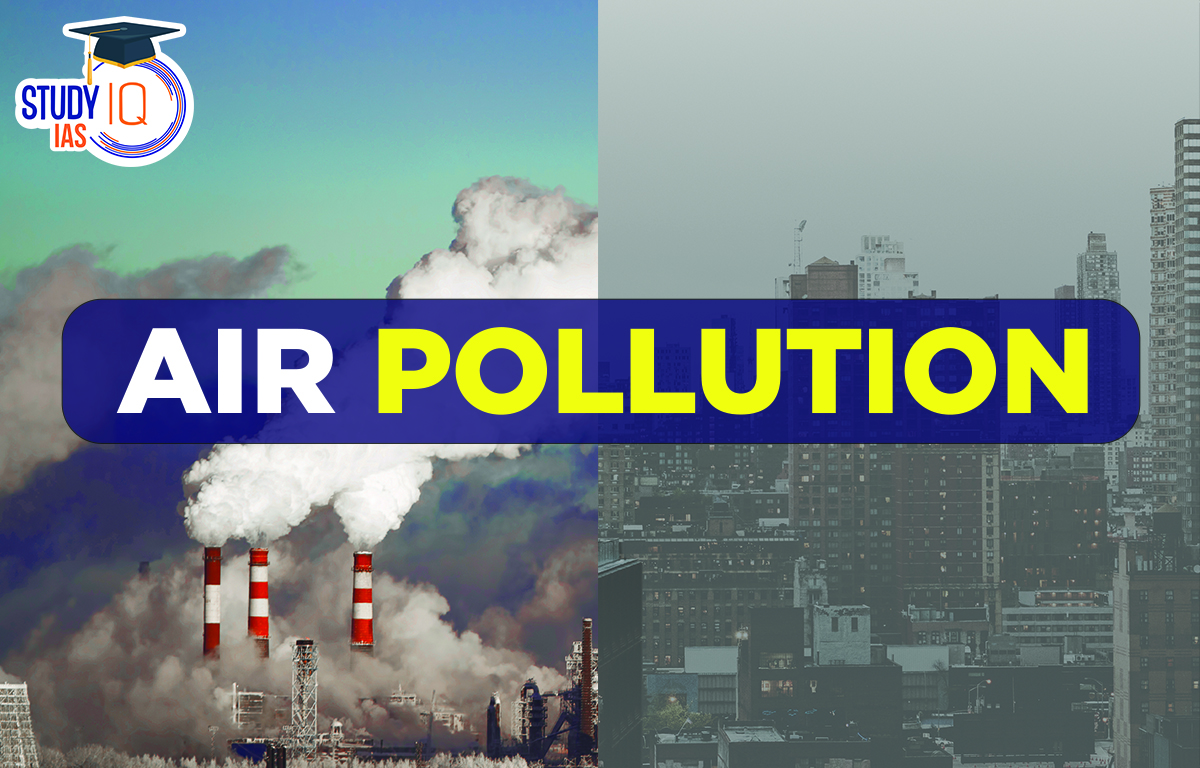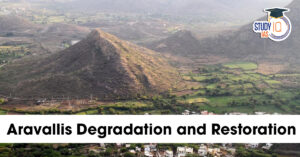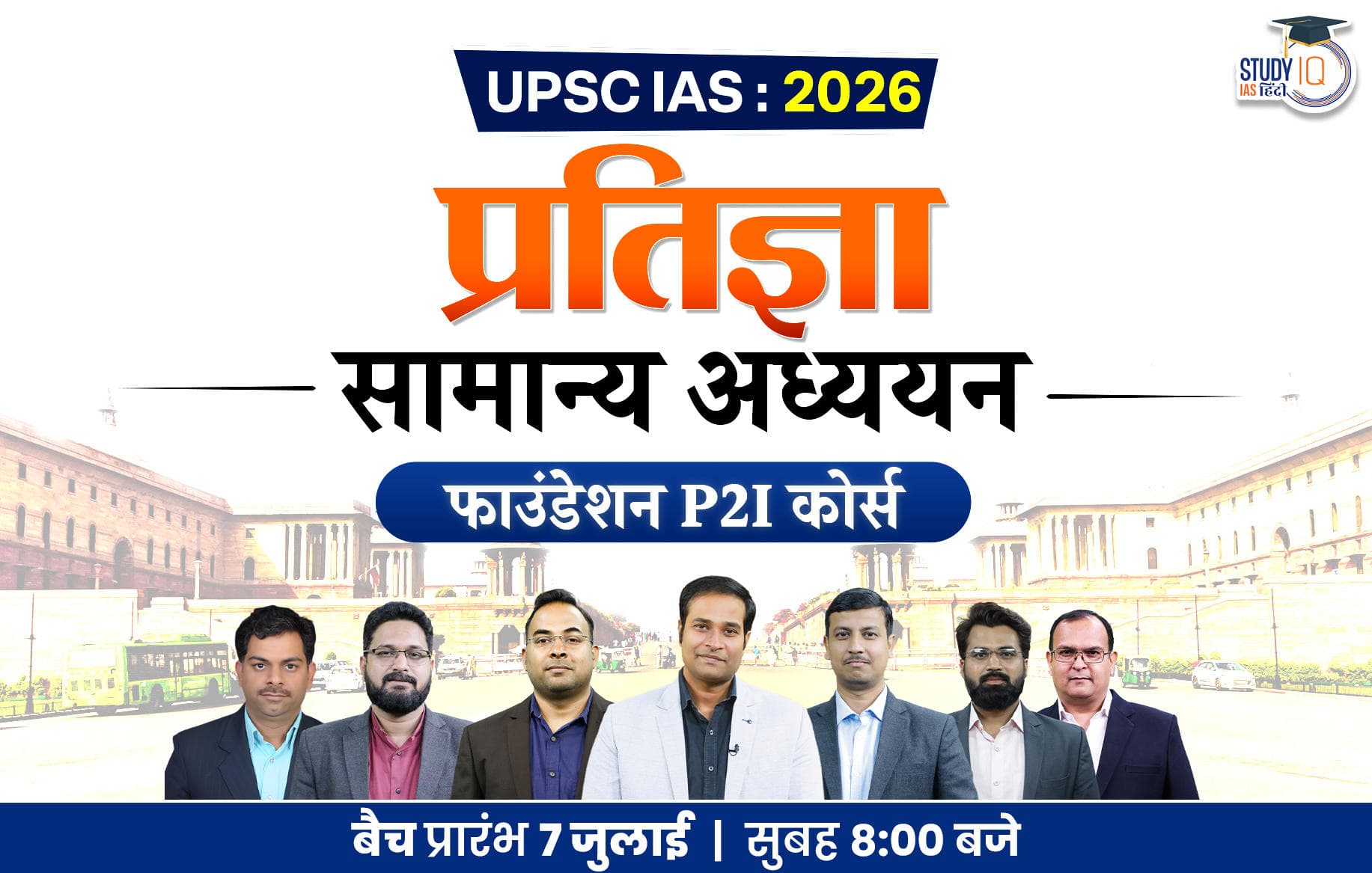Table of Contents
Context: A recent study conducted by researchers at IIT Delhi has found that air pollution and climate change will impair the efficiency of solar panels in India. India’s air pollution crisis is a year-round, silent pandemic rather than just a seasonal issue. Despite the successes of Make in India, India continues to lag in addressing air pollution, with Indian cities consistently ranking among the world’s most polluted.
Air Pollution
Air pollution happens when harmful substances are released into the air, making it bad for the environment and people’s health. The World Health Organization (WHO) says that about seven million people die each year because of air pollution. Right now, nine out of ten people are breathing air that is more polluted than what is safe according to the WHO. There are many kinds of air pollution, including gases like ammonia, carbon monoxide, sulfur dioxide, and methane, as well as tiny particles and biological materials.
- Primary pollutants are the ones that come directly from sources,
- while secondary pollutants are formed when primary pollutants mix.
If you are studying for the UPSC Civil Service Exam, this article will help you understand air pollution better.
Current Situation of Air Pollution in India
- India has very high air pollution, which harms health and the economy.
- All 1.4 billion people in India breathe unhealthy levels of PM 2.5, a harmful air pollutant.
- PM 2.5 can cause serious health issues like lung cancer, stroke, and heart disease.
- In 2019, air pollution caused 1.67 million deaths in India and cost the economy nearly $36.8 billion.
- PM 2.5 comes from burning fossil fuels, wood, and other materials, as well as dust from natural sources and construction.
- Over half of PM 2.5 forms when gas pollutants from agriculture, factories, power plants, homes, and vehicles mix in the air.
- To manage air pollution, India needs a regional approach, using standardised tools to link control strategies and gather data.
Findings of the Respirer Reports Analysis of Air Quality
- Increasing Pollution in Delhi: Over the last two years, Delhi has experienced a sharp rise in PM 2.5 pollution. In October 2021, the PM 2.5 concentration was measured at 74.0 μg/m3, which escalated by approximately 54% to 113.9 μg/m3 by October 2023. This level is alarmingly above the safety thresholds set by both the Central Pollution Control Board and the World Health Organization.
- Mumbai’s Deteriorating Air Quality: Mumbai has seen its PM 2.5 levels more than double from 27.7 μg/m3 in October 2019 to 58.3 μg/m3 four years later, marking a 110% increase.
- Rising Pollution in Hyderabad and Kolkata: After a brief improvement in 2022, Hyderabad’s air quality worsened with an 18.6% increase in PM 2.5 levels in October 2023.
- Kolkata also recorded a 40.2% hike in PM 2.5 levels compared to the previous year’s data for the same month.
- Reduction in PM 2.5 Levels in Other Capitals: In contrast, Lucknow, Patna, Bengaluru, and Chennai showed a decrease in PM 2.5 levels in October 2023, with Chennai registering a notable reduction of over 23%.
Check here: Pollution in Delhi
Severity of Air Pollution in India
- One of the World’s Worst Air Quality Levels: India consistently ranks among the most polluted countries (e.g., 6 of the world’s 10 most polluted cities are in India (2024 World Air Quality Report by IQAir).
- WHO’s air quality guidelines are exceeded in most Indian cities, with PM2.5 levels often reaching hazardous levels.
- High Mortality and Health Risks: According to the ICMR (2019), air pollution was linked to 7 million deaths in India.
- The Lancet Countdown and WHO highlight that air pollution is a major risk factor for lung cancer, cardiovascular diseases, stroke, and diabetes.
- Severe Impact on Children and Vulnerable Groups: Prolonged exposure to pollution affects lung development in children, leading to asthma and respiratory infections.
- The elderly and those with pre-existing health conditions suffer from aggravated cardiovascular and respiratory diseases.
- Economic and Productivity Loss: Air pollution-related diseases contribute to billions in lost productivity annually.
- Increased healthcare costs burden both individuals and the public health system.
- Seasonal and Year-Round Crisis: While winter smog is a major issue due to stubble burning and temperature inversion, high pollution persists throughout the year due to vehicular emissions, industrial activity, and biomass burning.
- Urban and Rural Divide: While urban areas suffer from vehicular and industrial pollution, 41% of India’s population still relies on solid biomass fuels for cooking, emitting 340 million tonnes of CO₂ annually and worsening indoor air pollution.
Air Pollution Causes
1. Fossil Fuels
Sulfur dioxide is one of the main causes of air pollution. It comes from burning fossil fuels like coal and oil in power plants and other industries. The gasoline and diesel used in millions of cars and trucks also contribute to this pollution, as petroleum doesn’t burn cleanly in engines. High pollution levels are caused by harmful substances released from vehicles like trucks, cars, trains, and aeroplanes. These pollutants include tiny particles (PM), nitric oxide, and nitrogen dioxide (together called NOx), as well as carbon monoxide, organic compounds, and lead. Carbon monoxide comes from cars and is created when fuel doesn’t burn completely.
2. Agricultural Activities
Ammonia, a byproduct of farming, is one of the most harmful substances in the air. Today, fertilisers, pesticides, and insecticides are widely used in agriculture, which can pollute water and release harmful chemicals into the air. Farmers also burn fields and old crops to prepare for new planting, and this burning adds dangerous pollutants to the air.
3. Waste on Landfills
The places where trash is buried or put are called landfills. These dumped or buried wastes generate methane. An important greenhouse gas that is highly flammable and hazardous is methane. Another severe problem is e-waste, which entails several unethical activities such as chemical leaks and burning wires.
4. Industrial Dust and Waste
Manufacturing industries release a lot of carbon monoxide, hydrocarbons, and other harmful chemicals into the air, which lowers air quality. Petroleum refineries also release hydrocarbons and other pollutants, damaging both the air and the land.
5. Mining Operation
Mining is the use of large machinery to remove minerals from below the surface of the earth. During the process, chemicals and dust are released into the air, causing serious air pollution. This is one of the elements causing the local population’s and workers’ declining health.
- Indoor Pollution: Hazardous chemicals are released into the air by household cleaning goods and painting supplies, damaging the environment.
- Natural Factors: The air is contaminated by some naturally occurring events, such as volcanoes, forest fires, and dust storms.
Sources of Air Pollutants
1. Carbon Monoxide
It is a colourless, odourless gas that is produced when carbon-based fuels like gasoline, diesel, and wood, as well as organic and synthetic materials like cigarettes, burn incompletely. Our bloodstream holds less oxygen as a result. It can slow our responses and make us fatigued, which can make us confused.
2. Carbon Dioxide (CO2)
It is the main greenhouse gas produced by human activities such as the burning of coal, oil, and natural gas. Natural sources of CO2 include volcanoes, hot springs, and geysers. CO2 is released from carbonate rocks by dissolving in water and acids. A suffocating gas is CO2 (asphyxia: a condition arising when the body is deprived of oxygen, causing unconsciousness or death.). Concentrations of 7% can cause hypoxia, which presents as headache, dizziness, and unconsciousness even when there is enough oxygen present.
3. Chlorofluorocarbons (CFC)
These are gases that are mostly released by refrigeration and air conditioning units. CFCs rise to the stratosphere after being released into the atmosphere, where they combine with a few other gases and weaken the ozone layer, which shields the earth from the sun’s dangerous UV rays.
4. Lead
Among other things, lead can be found in paints, hair dyes, lead batteries, gasoline, diesel, and other products. Lead poisoning can be particularly dangerous for children. It may cause issues with the digestive system, the nervous system, or even cancer in some cases.
Types of Air Pollutants
Particulate Matter (PM)
- PM10: Particles with diameters that are 10 micrometres and smaller.
- PM2.5: Fine particles with diameters that are 2.5 micrometres and smaller.
These particles can be made up of various components, including acids (such as nitrates and sulphates), organic chemicals, metals, soil or dust particles, and allergens (such as fragments of pollen or mould spores).
Gaseous Pollutants
- Carbon Monoxide (CO): A colourless, odourless gas produced by the incomplete combustion of fossil fuels.
- Sulphur Dioxide (SO2): A gas produced by volcanic eruptions and industrial processes, particularly the burning of coal and oil at power plants and the refining of oil.
- Nitrogen Oxides (NOx): Gases that include nitrogen dioxide (NO2) and nitric oxide (NO), produced from vehicle emissions, power plants, and off-road equipment.
- Volatile Organic Compounds (VOCs): Organic chemicals that have a high vapour pressure at ordinary room temperature, such as benzene, toluene, and formaldehyde. They are emitted from certain solids or liquids, like paints and lacquers, cleaning supplies, and gasoline.
- Ammonia (NH3): A gas emitted from agricultural processes, particularly from livestock waste and fertilisers.
Persistent Organic Pollutants (POPs)
These are organic compounds that are resistant to environmental degradation and include chemicals like polychlorinated biphenyls (PCBs), dioxins, and pesticides.
Heavy Metals
- Lead (Pb): Once widely used in gasoline and paint, still found in some industrial emissions.
- Mercury (Hg): Emitted from coal combustion and some industrial processes.
- Cadmium (Cd) and Arsenic (As): Other toxic metals that can be found in industrial emissions.
Ground-level Ozone (O3)
A secondary pollutant is formed when VOCs and NOx react in the presence of sunlight. Not to be confused with the protective ozone layer in the upper atmosphere.
Secondary Pollutants
- These are not emitted directly. Rather, they form in the air when primary pollutants react or interact.
- Ground-level ozone and particulate matter formed from NOx and SO2 are examples of secondary pollutants.
Greenhouse Gases
Although not always considered “pollutants” in the traditional sense because they don’t directly impact human health, greenhouse gases like carbon dioxide (CO2), methane (CH4), and nitrous oxide (N2O) are crucial to the discussion of air pollution due to their impact on climate change.
Radioactive Pollutants
Radon (Rn) and its decay products, and airborne particles from nuclear accidents or detonations.
Bioaerosols
Biological particles, or bioaerosols, such as bacteria, viruses, fungal spores, or fragments of plant material, can also be considered air pollutants, particularly indoors or in specific workplace settings.
Check Here: Pollution and its Types
Air Pollution Effects
1. Health Issues
Air pollution has a serious impact on human health. It is linked to many health problems, like cancer, heart attacks, strokes, emphysema, chronic bronchitis, and asthma. Millions of deaths are caused by air pollution, either directly or indirectly.
Pregnant women exposed to high levels of air pollution are at risk for premature birth, autism, asthma, and other early development issues. It can also harm a child’s brain development and cause pneumonia, which kills about a million children under five each year. In polluted areas, children are more likely to get short-term respiratory infections and lung diseases.
2. Global Warming
The changes happening to our planet are mainly due to global warming. Climate change, loss of habitats, animals moving to new places, and rising sea levels from melting ice are all signs that we might face a big crisis if we don’t act quickly to protect the environment.
3. Acid Rain
When fossil fuels are burned, harmful substances like sulfur oxides and nitrogen oxides are released into the air. When it rains, these pollutants mix with the raindrops to form acid, which falls to the ground as acid rain. Acid rain can harm people, animals, and crops.
4. Eutrophication
Eutrophication happens when a lot of nitrogen from pollution builds up in the water, leading to too much algae growth. This can harm fish, plants, and other living things. The release of nitrogen from factories also causes green algae to grow in lakes and ponds.
5. Ozone Layer Depletion
Ozone in the Earth’s stratosphere protects us from harmful ultraviolet (UV) rays. However, substances like hydrochlorofluorocarbons and chlorofluorocarbons are hurting the ozone layer. When the ozone layer gets thinner, more harmful rays reach the Earth, which can cause skin and eye problems. UV rays can also damage crops.
Check here: Ozone Layer Depletion
Air Pollution Prevention
The government plans to update air quality standards and has improved rules for vehicle and industrial emissions. They are also focusing on renewable energy, promoting electric vehicles, and providing LPG cooking fuel to many households.
The National Clean Air Programme (NCAP) aims to improve air quality nationwide, especially in 132 cities where pollution is high. The NCAP helps cities create air quality management plans and gives guidance on various policies.
In 2020, India set aside about $1.7 billion to help 42 major cities reduce air pollution by 15% each year. This is the world’s first funding program based on performance for air quality.
To coordinate efforts across regions, India’s Parliament approved a law in August 2021 to create the Commission of Air Quality Management for the National Capital Region and nearby areas.
1. Usage of Public Transport and Carpooling
We can reduce air pollution and the number of harmful substances in the air by using less fuel for transportation. These choices also make financial sense and can help save money.
2. Putting the Lights off when off no use
Most of our electricity is generated through the burning of fossil fuels, which significantly contributes to air pollution. Consequently, using less electricity to prevent air pollution is a good idea.
3. Reusing and Recycling Products
Reusing old products saves energy that would be used to make new ones. Recycling items also saves energy compared to making new products from scratch.
4. Avoiding Smoking and Garbage Burning
Burning trash causes a lot of air pollution, and smoking cigarettes adds to the problem too. We can help prevent air pollution by avoiding these activities and understanding how they harm the environment.
5. Limiting the Usage of Fireworks
People often use firecrackers to celebrate special events, but they can harm the environment and cause a lot of air pollution. To help reduce air pollution, it’s a good idea to avoid using firecrackers and to spread the word about their negative effects.
| What is the Air Quality Index? |
|
Check here: World Air Quality Report
How Climate Change and Air Pollution Affect Solar Energy
Global Dimming and Brightening
- Air pollution reduces solar radiation reaching the Earth’s surface, affecting solar panel efficiency.
- Over time, solar radiation undergoes significant variations due to changes in atmospheric conditions.
- These variations are known as global dimming (less radiation reaching the surface) and global brightening (more radiation reaching the surface).
Role of Atmospheric Components
- Clouds reflect incoming solar radiation, reducing the sunlight available for solar panels.
- Aerosols and particulate matter (PM2.5, PM10) either scatter or absorb sunlight, further reducing radiation.
- Water vapour and ozone influence the amount of solar energy that reaches the surface.
- On cloudy or hazy days, particulate matter pollution significantly reduces solar panel output.
| Factors Affecting Solar Panel Performance |
|
Key Findings of the Study
Projected Drop in Solar Panel Efficiency
- By mid-century (2041-2050), India’s solar panel efficiency will drop by 2.3%.
- The total estimated energy loss due to reduced efficiency is 840 gigawatt-hours (GWh) per year.
Impact of Temperature Increase
- Solar cell temperatures will rise by 2°C by 2050 due to higher ambient temperatures.
- Ambient temperature refers to the surrounding air temperature.
Regional Variations in Solar Potential
- India’s Northeast and Kerala will experience an increase in solar potential in the future.
- Reason: Cloud cover is expected to decrease over these regions, allowing more solar radiation to reach panels.
| India’s Solar Power Ambitions |
|
Where India Lags in Tackling Air Pollution
Fragmented Governance & Poor Coordination
- Air pollution is a multi-sectoral issue requiring coordination across ministries (environment, transport, industry, urban development), but India lacks an integrated approach.
- Example: The National Clean Air Programme (NCAP) is implemented at the central level, but local authorities lack execution capacity and funding clarity.
Insufficient Budget & Resource Allocation
- India’s NCAP budget is less than 1% of China’s air quality spending (~₹11,542 crore vs. ₹22 lakh crore over five years).
- Low fund utilization (only 60% between 2019-2023) due to bureaucratic delays and unclear accountability.
Weak Monitoring & Data Gaps
- Dependence on ambient air quality data, which fluctuates due to weather, rather than tracking emission reductions.
- Lack of high-resolution data on emission hotspots (waste burning, traffic congestion, industrial pollution).
Overreliance on High-Tech Solutions Without Structural Fixes
- Smog towers and AI dashboards look promising but do not address core pollution sources like biomass burning, vehicular emissions, and industrial waste.
- Many global cities prioritized systemic changes (clean fuels, emission controls) before adopting high-tech tools.
Neglect of Rural & Informal Sectors
- Pollution control policies focus on metro cities, ignoring rural areas and informal industries (brick kilns, small-scale manufacturing).
- Without targeted interventions, pollution from these sectors continues to rise.
Lack of Immediate, Scalable Solutions
- Heavy focus on long-term research instead of short-term, actionable programs for local governments.
- Cities lack separate funds for immediate interventions (like phasing out old vehicles or upgrading industrial emissions standards).
What Needs to Be Done?
Adopt a Data-Driven, Phased Approach (California Model)
- Phase I: Identify major local pollution sources (vehicle type, industrial zones, solid fuel use).
- Phase II: Link government funding directly to emission-reducing actions (e.g., retrofitting diesel buses, waste management).
- Phase III: Measure progress by tracking emission reductions, not just air quality levels.
Increase Budget & Targeted Investments (China’s Air Cleanup Strategy)
- China spent ₹22 lakh crore over five years, shutting down coal plants, incentivizing green energy, and upgrading industrial processes.
- India needs a dedicated, long-term air quality budget with clear spending goals across transport, industry, and household energy.
Strengthen Local Governance (Brazil’s Community-Led Waste Model)
- Brazil’s community-led waste model emphasizes partnerships between public, private, and community sectors for sustainable waste management.
- Decentralize air quality management, empowering municipalities with direct funds and decision-making powers.
Focus on Structural Reforms (London’s Coal Ban Before Sensors)
India should prioritize phasing out outdated industrial processes, promoting electric public transport, and enforcing stricter fuel regulations.
Incentivize Cleaner Alternatives (California’s Reinvestment in Poor Communities)
India should redirect pollution-related revenues into affordable clean energy solutions like LPG for rural households and electric mobility subsidies.
Enforce Accountability (EU’s Strict Monitoring System)
India needs stronger legal frameworks with real-time pollution penalties, citizen reporting mechanisms, and transparent public data on air quality.
Challenges Associated with Air Quality Management in India
- Underutilised Funds: Although funding is available, pollution control boards often return unspent funds, indicating inefficiencies in utilisation rather than resource scarcity.
- Research & Dependence on Foreign Agencies: India relies heavily on foreign-funded air quality studies and international data sets, making it vulnerable, especially when foreign agencies scale back.
- Indigenous efforts like SAFAR (2010) have shown promise but remain underutilized, limited to only a few cities.
- Institutional Challenges: Elite capture of research funding limits broader institutional participation.
- Collaboration between top Indian agencies like the Earth System Science Organisation – India Meteorological Department (ESSO-IMD) and the Central Pollution Control Board (CPCB) is inadequate but essential for national-level forecasting and management.
- City-centric Approach to Pollution: Focus is on city-level solutions rather than comprehensive airshed-based management.
Way Forward – Atmanirbharta in Air Quality
- A unified, science-based air quality resource framework is critical.
- Initiatives like NARFI (National Air Quality Resource Framework of India) aim to promote airshed-level management, inter-agency coordination, and evidence-based policy.
- India must move from city-centric to health- and food-centric airshed approaches to achieve real self-reliance (Atmanirbharta) in environmental governance.


 Aravallis Degradation and Restoration: I...
Aravallis Degradation and Restoration: I...





















